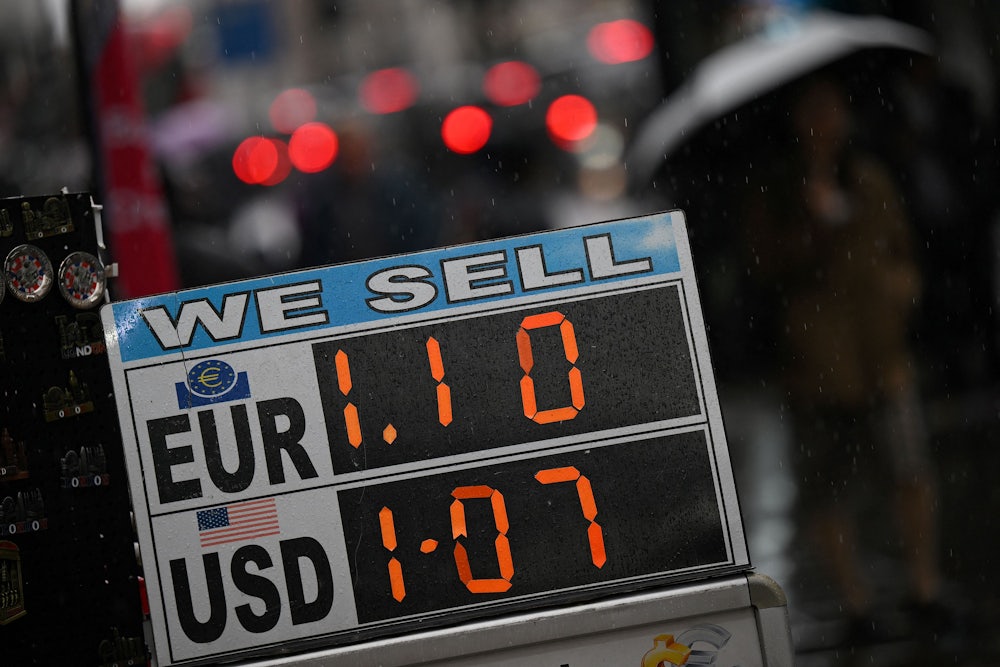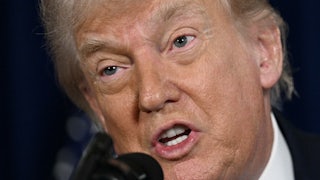The current rise of the dollar against foreign currencies has me remembering a 1987 photo op in which sledgehammer-wielding Republican House members—the Capitol dome looming behind them—smashed a large battery-operated Toshiba radio/cassette player. The proximate cause for the protest was Toshiba’s sale of high-tech equipment to the Soviet Union. But that was just a pretext. The legislators’ real complaint was against a ballooning trade deficit with Japan, worsened by a too strong dollar.
The next time the dollar peaked was in 2002. It didn’t rise as high as in the mid-1980s, so less fuss was made about the damage that did to American exports, but there was some fuss. Now the dollar is peaking again, and this time there’s practically no fuss at all. In The New York Times, Patricia Cohen (who’s written insightfully on this topic in the past) published a story Monday about the benefits to the United States of a strong dollar (and the corresponding harm to other nations) without once acknowledging a strong dollar’s dampening effect on U.S. exports. A rising dollar is no longer something to smash a boom box over.
There are a few rational reasons for this. The dollar is especially strong right now because the Federal Reserve is trying to put the brakes on inflation, and inflation is a much bigger worry for the working class at the moment than foreign competition. The war in Ukraine has choked off oil and grain from Ukraine and Russia, pushing up demand for U.S. exports of these commodities. Exports of American-made cars remain fairly robust too.
But I submit that another reason you don’t hear much talk about the potential harm a rising dollar does to U.S. exports is that with a steadily growing trade deficit—and a negative balance of trade in goods and services that today approaches 10 times its size in 1987—the only export people really care about anymore is the dollar.
The dollar, you’ve no doubt heard, is the world’s reserve currency. Back in the 1980s, fewer than half of all dollars resided abroad. Today it’s more like 80 percent. Foreigners love our dollars, and it’s a good thing they do, because if they didn’t we’d have to work a lot harder to lower the budget deficit and the trade deficit. American policymakers don’t want to discourage the world’s love affair with our currency. Indeed, they can’t even be persuaded to eliminate $100 bills, a currency that (as I’ve noted before) is confined almost exclusively to unwholesome (usually criminal) activity. They won’t ban the Benjamins because they fear a corresponding market share increase for the 500 euro note (informally known as the “bin Laden”). Markos Kounalakis, a visiting fellow at Stanford’s Hoover Institution, proposed in The Wall Street Journal in May that we stop sending Benjamins just to Russia, to starve the oligarchs. Nobody wants to do even that!
Government officials used to equivocate about the value of a strong dollar. If it was too high, they would work very publicly to bring it down. In 1985, Treasury Secretary James Baker met at New York City’s Plaza Hotel with finance ministers from West Germany, Japan, France, and the United Kingdom to depreciate the dollar against those nations’ currencies. The trade deficit took a few years to shrink (hence the smashed Toshiba boom box in 1987), but eventually a weakened dollar did shrink it. The Plaza Accords were judged a great triumph for the Reagan administration. Hurrah! We made the dollar weaker!
There have been a few subsequent efforts to reduce the dollar’s value, but not a lot, and if you never heard about them that’s because they were done very sotto voce. Starting in the 1990s, all presidential administrations, Republican and Democratic, swore allegiance to the cult of the strong dollar. “A strong dollar will always be in the interest of the United States,” said Treasury Secretary Tim Geithner in 2011. In January 2018, Treasury Secretary Steve Mnuchin briefly stated that a weaker dollar would be good for U.S. trade, echoing his boss, President Donald Trump. But after that caused an immediate drop in the dollar’s value, Mnuchin assured CNBC that no, no, no—strong dollar good! and promised never to muck around in the currency markets (as Baker had done and as Trump wanted Mnuchin to do).
“To advocate a strong dollar sounds patriotic, even though it’s not good for your trade balance,” Steven R. Weisman, who covered the Reagan White House for The New York Times and is now vice president for communications at the nonprofit Peterson Institute, told me. “No one wants to come out and say, ‘I want a weak dollar,’ because it sounds weak.”
Nobody is going to call for a weaker dollar right now because inflation is the government’s top economic concern, and rightly so. But except for a brief dip in 2017–18, due apparently to strong economic growth in Europe, and an even briefer pandemic dip, the dollar has been on an upward trajectory since 2011. If this occasioned any Toshiba-smashing, I missed it.
We live in a different world than the 1980s. In addition to today’s fatter trade deficit, the basket of U.S. exports has changed. Manufactured goods make up a smaller proportion, explains Edwin Truman, a senior fellow at the Mossavar-Rahmani Center for Business and Government at Harvard’s Kennedy School, and commodities like oil and grain make up a larger proportion. Also, the dividing line between American-made goods and foreign-made goods has gotten much blurrier, with more U.S. companies manufacturing abroad, more foreign companies manufacturing here, and the components of, say, an automobile a mishmash of foreign and domestic provenance. China has displaced Japan as our biggest export rival, and if you want to smash something Chinese, what’s it going to be? Japanese products are identifiable brands, but Chinese products generally aren’t. They’re just kind of … everything.
Another factor is that as we import more products, policymakers worry more about the potential inflationary effect from raising their price. Our country is so hooked on foreign-made goods and components that politicians fear hiking import prices more than they desire to sell U.S. products abroad.
This could all change, Truman says, if we enter a recession. But it seems to me it takes an awful lot these days to get anybody even to acknowledge the damage a strong dollar can do to U.S. exports. So long as the price of a dollar stays high, America’s export market is judged safe.






